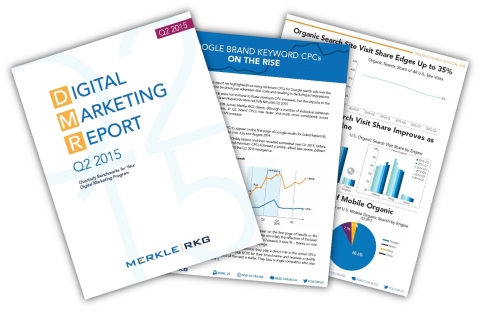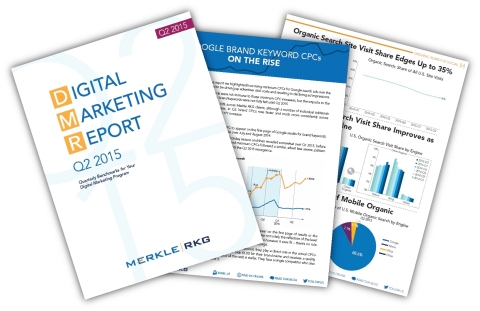COLUMBIA, Md.--(BUSINESS WIRE)--Merkle (www.merkleinc.com), a leading technology-enabled, data-driven performance marketing agency, announced the release of its Q2 2015 Merkle|RKG Digital Marketing Report. The report provides comprehensive and detailed insights into digital marketing trends, using data from the agency’s vast client base to analyze activity in paid search, SEO, social media, product ads, display advertising, comparison shopping engines, and more.
Google growth continued to slow in Q2 2015, as paid search ad spending increased by just 12% YoY, down from 24% a year earlier. Google click traffic growth fell by 1%, as advertisers continue to face a higher average cost-per-click (CPC). Advertisers paid significantly higher costs to appear for their own brand names on Google in Q2 2015, seeing on average a 40% higher CPC. While Google has officially reported falling CPCs year-over-year, their numbers are reduced by low YouTube CPCs; Merkle|RKG data shows that Google-specific paid search CPCs rose 13% over last year in Q2.
Bing Ads growth also slowed from last quarter, but is still strong compared to last year. Paid search ad spending on Bing increased by 27% from Q2 2014, driven by a 24% increase in ad clicks. Bing ad CPCs grew by just 2%.
Meanwhile, Facebook ad spend and CPCs continue to rise; advertisers spent 69% more on Facebook ads, including Facebook Exchange (FBX), in Q2 this year compared to 2014. Both click volume and CPC increases contributed to the overall increase in investment, with the latter up 30% year-over-year.
Google, Yahoo, and Bing Continue to Jockey for Search Share
With Bing Ads striking a deal to replace Google as the default search provider for AOL, Merkle|RKG data shows that AOL produced 1% of overall Google search ad clicks in Q2 2015, a sizeable portion of the 8% share of Google clicks that search partners produced overall. This follows Google’s loss of default search status on Firefox in Q4 2014, which resulted in it losing 2% of the overall U.S. search market. Also at stake is Google’s status as the default search provider for the Safari browser and iOS devices, which produced 35% of search ad clicks in Q2 2015.
Yahoo’s new search platform, Gemini, now accounts for 15% of total Bing and Yahoo paid search clicks across all devices, among advertisers who have adopted the program. Gemini traffic share jumped 2.2 points from April to May following the announcement that Yahoo could begin serving Gemini ads for desktop traffic. Yahoo also recently confirmed that it has tested running Google search ads on its domains; Merkle|RKG data finds that Google search ads produced 31% higher conversion rates than Bing Ads in Q2.
Amazon Increases Its Presence in Google Paid Search, Despite Shunning Product Ads
Although it has avoided Google Product Listing Ads (PLAs), Amazon’s presence in Google text ad auctions has increased significantly. Over the last three years, Amazon’s text ad impression share has nearly doubled across multiple retail industries.
Amazon’s own product ad format continues to see success, with advertiser revenue from Amazon Product Ads up 85% year-over-year. Advertisers running both Amazon Product Ads and Google PLAs saw Amazon drive revenue equal to 17% of that driven by Google PLAs in Q2, nearly double the 9% figure from Q2 of last year.
Google Buy Button “Imminent”; Merkle|RKG Data Offers Context
As Google’s buy button functionality for PLAs on phones appears imminent, Merkle|RKG found phone revenue-per-click running 58% lower than desktop in Q2 2015. By clicking the buy button, users would be directed to a Google website where they could complete their purchase. Doing so may ease the mobile buying process, as users could use Google-saved information to purchase and would be guaranteed a mobile-friendly experience. However, some advertisers have expressed concerns over the ability to cross-sell and upsell with Google handling the customers experience; Merkle|RKG finds that PLAs are already producing 13% smaller orders than text ads.
Other Q2 Highlights Include:
Paid Search:
- Overall paid search spending grew 14% year-over-year (versus 17% in Q1). Clicks were up 3% while CPCs were up 11%.
- Phones and tablets produced 41% of paid search clicks and commanded 31% of spending. Tablet click growth has slowed to just 1% year-over-year, while phone clicks increased 35%.
Organic Search
- Organic search visits increased 12% year-over-year, with phone visits up 44%, desktop visits up 4%, and tablet visits just 1% higher from last year. Organic search visit growth has improved in recent quarters as paid search click growth has slowed.
- Google continues to show relative strength in mobile where it produced 89% of U.S. organic search visits, compared to 86% of U.S. organic search visits overall.
Social Media Advertising
- Mobile devices generated 61% of sites’ social media visits, a rate that has increased sharply since Facebook pushed out fixes for iOS and Android to reduce the amount of traffic that did not pass a referrer to site owners.
- Facebook produced nearly 60% of social media-driven visits in Q2 2015, up from 51% in Q2 2014. Pinterest generated 18% of social site visits on average in Q2, but often produced a higher share for retailers making concerted efforts on the site.
Comparison Shopping Engines
- While the eBay Commerce Network (ECN) maintained the greatest share of comparison shopping engine (CSE) spend at 38% in Q2 2015, Connexity’s recent acquisition of PriceGrabber may lead to a new market leader as the firms combined for 44% of CSE spending.
- For advertisers running both Amazon Product Ads and Google PLAs, Amazon Product Ads produced 17% as much revenue as PLAs in Q2 2015, a slight decrease from 19% in Q1 215, but well above Q2 2014 levels of 9%.
Display Advertising
- Cost-per-click of Facebook ads, including FBX and native ads, increased 30% year-over-year in Q2 2015, while ad spending rose 69%.
- The share of spend allocated to the Google Display Network (GDN) for advertisers bidding on both search and display was 11% in Q2 2015, up from 6% in Q2 2014.
About Merkle
Merkle is a global data-driven, technology-enabled performance marketing agency and the largest independent agency in the US for CRM, digital, and search. For more than 25 years, Fortune 1000 companies and leading nonprofit organizations have partnered with Merkle to maximize the value of their customer portfolios. The agency’s heritage in data, technology, and analytics forms the foundation for its unmatched skills in understanding consumer insights. When combined with its strength in performance media, Merkle creates customer experiences that drive improved marketing performance and shareholder value. With more than 2,700 employees, the privately held corporation is headquartered in Columbia, Maryland with 14 additional offices in the US and offices in London, Shanghai and Nanjing. For more information, contact Merkle at 1-877-9-Merkle or visit www.merkleinc.com.




